2005 SUBARU BAJA steering wheel
[x] Cancel search: steering wheelPage 87 of 469

1-62
Seat, seatbelt and SRS airbags
low, we recommend that you have an autho-
rized SUBARU dealer perform the work. The
SRS airbag control module, impact sensors
and airbag modules are stored in these areas. �y
Under the center console
�y Inside each front fender
�y Steering wheel and column and nearby areas
�y Top of the dashboard on front passenger’s
side and nearby areas
�y Inside each center pillar
In the event that the SRS airbag is deployed, re-
placement of the system should be performed
only by an authorized SUBARU dealer. When the
components of the SRS airbag system are re-
placed, use only genuine SUBARU parts.
To ensure their long-term reliability, the SRS airbags
must be inspected by a SUBARU dealer ten years af-
ter the date of manufacture, which is shown on the cer-
tification label attached to the driver’s door.
NOTE
In the following cases, contact your SUBARU deal-
er as soon as possible. �y The front part of the vehicle was involved in an
accident in which the SRS frontal airbags did not deploy.�y
The pad section of the steering wheel or front
passenger’s frontal airbag cover is scratched,
cracked, or otherwise damaged. �„ Precautions against vehicle modifica- tion
�yTo avoid accidental activation of the system
or rendering the system inoperative, which may
result in serious injury, no modifications
should be made to any components or wiring of
the SRS airbag system.
This includes following modifications:
�yInstallation of custom steering wheels
�y Attachment of additional trim materials to
the dashboard
�y Installation of additional electrical/electronic
equipment such as a mobile two-way radio on
or near the SRS airbag system components
and/or wiring is not advisable. This could inter-
fere with proper operation of the SRS airbag
system.
Page 124 of 469

3-1
3
Instruments and controls
Ignition switch .............................................. 3-2 LOCK .................................................................. 3-2
ACC .................................................................... 3-3
ON ....................................................................... 3-3
START ................................................................ 3-4
Key reminder chime .......................................... 3-4
Ignition switch light (if equipped) .................... 3-4
Key interlock release (AT vehicles) ................. 3-4
Hazard warning flasher ................................ 3-5
Meters and gauges ....................................... 3-6 Speedometer ..................................................... 3-6
Odometer/Trip meter ........................................ 3-6
Tachometer ........................................................ 3-7
Outside temperature indicator (if equipped) .. 3-7
Fuel gauge ......................................................... 3-8
Temperature gauge ........................................... 3-8
Warning and indicator lights ....................... 3-9 Seatbelt warning light and chime .................... 3-9
SRS airbag system warning light .................... 3-10
CHECK ENGINE warning light/Malfunction indicator lamp ................................................. 3-10
Charge warning light ........................................ 3-11
Oil pressure warning light ................................ 3-12
AT OIL TEMPerature warning light (AT vehicles) ................................................... 3-12
ABS warning light ............................................. 3-12
Brake system warning light ............................. 3-13
Door ajar warning lights ................................... 3-14
Switchback door indicator light ...................... 3-14
Low fuel warning light ...................................... 3-14
All-Wheel Drive warning light (AT vehicles) ... 3-14 Security system status indicator light
(if equipped) .................................................... 3-15
Selector lever position indicator (AT vehicles) ................................................... 3-15
Gear position indicator (Turbo-AT vehicles) .. 3-16
Turn signal indicator lights .............................. 3-16
High beam indicator light ................................. 3-16
Cargo lamp indicator light ............................... 3-16
Cruise control set indicator light .................... 3-16
Clock .............................................................. 3-17
Light control switch ...................................... 3-18 Headlights ......................................................... 3-18
High/low beam change (dimmer) .................... 3-19
Headlight flasher ............................................... 3-19
Daytime running light system ......................... 3-20
Turn signal lever ........................................... 3-20
Illumination brightness control ................... 3-21
Parking light switch ...................................... 3-22
Fog light button ............................................. 3-23
Wiper and washer ......................................... 3-23 Windshield wiper and washer switches ......... 3-25
Rear window defogger button ..................... 3-26
Windshield wiper deicer (if equipped) ........ 3-27
Mirrors ............................................................ 3-28 Inside mirror ...................................................... 3-28
Outside mirrors ................................................. 3-30
Tilt steering wheel ......................................... 3-33
Horn ................................................................ 3-34
Page 125 of 469
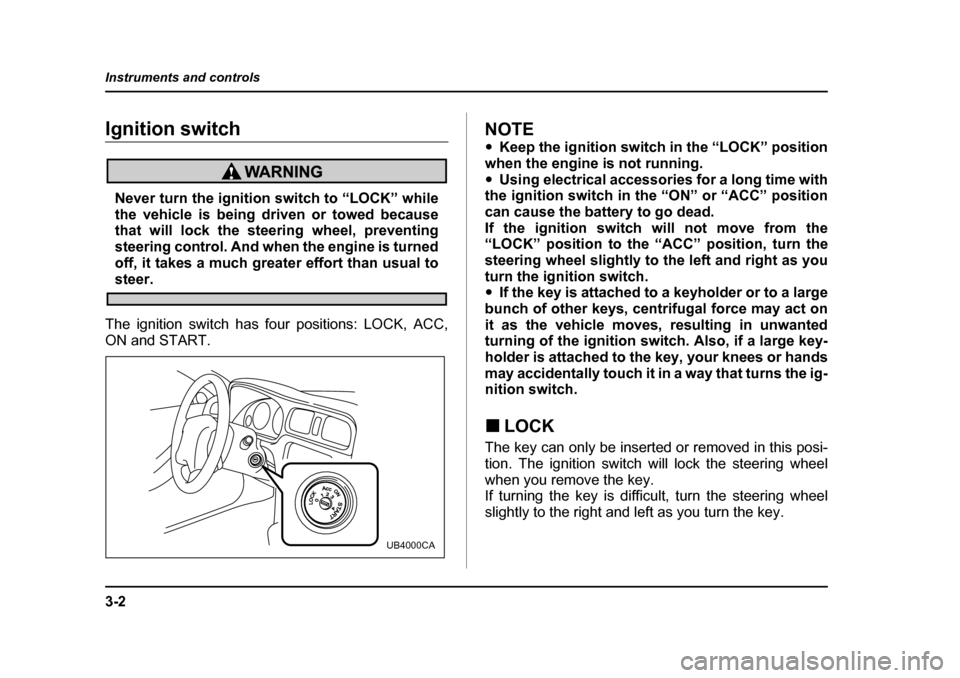
3-2
Instruments and controls
Instruments and controlsIgnition switch
Never turn the ignition switch to “LOCK” while
the vehicle is being driven or towed because
that will lock the steering wheel, preventing
steering control. And when the engine is turned
off, it takes a much greater effort than usual to
steer.
The ignition switch has four positions: LOCK, ACC,
ON and START.
NOTE �y Keep the ignition switch in the “LOCK” position
when the engine is not running. �y Using electrical accessories for a long time with
the ignition switch in the “ON” or “ACC” position
can cause the battery to go dead.
If the ignition switch will not move from the
“LOCK” position to the “ACC” position, turn the
steering wheel slightly to the left and right as you
turn the ignition switch. �y If the key is attached to a keyholder or to a large
bunch of other keys, centrifugal force may act on
it as the vehicle moves, resulting in unwanted
turning of the ignition switch. Also, if a large key-
holder is attached to the key, your knees or hands
may accidentally touch it in a way that turns the ig-
nition switch. �„ LOCK
The key can only be inserted or removed in this posi-
tion. The ignition switch will lock the steering wheel
when you remove the key.
If turning the key is difficult, turn the steering wheel
slightly to the right and left as you turn the key.
UB4000CA
Page 156 of 469
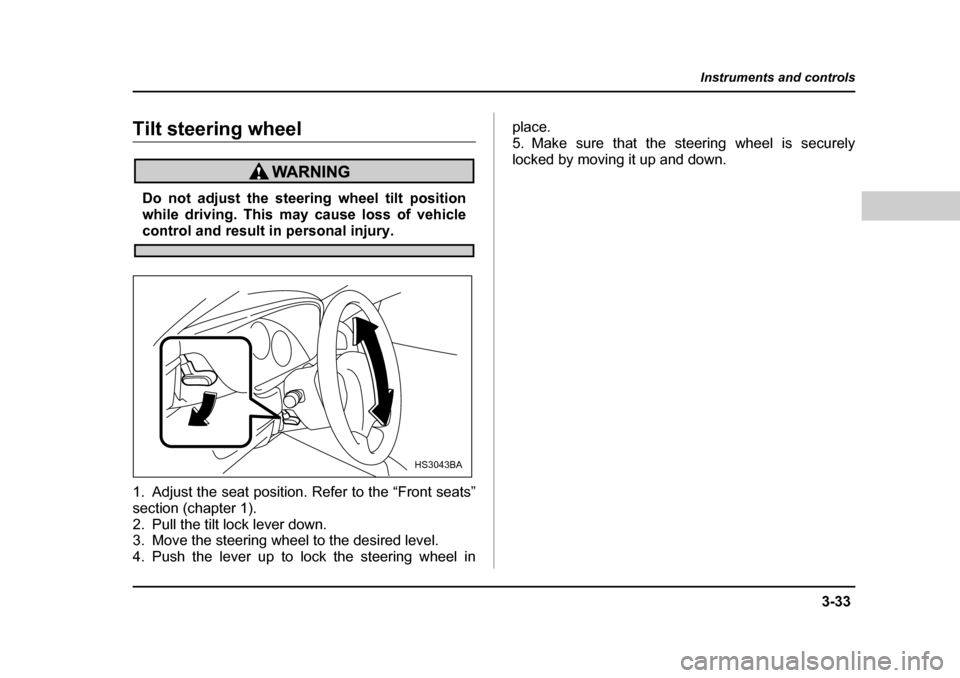
3-33
Instruments and controls
– CONTINUED –
Tilt steering wheel
Do not adjust the steering wheel tilt position
while driving. This may cause loss of vehicle
control and result in personal injury.
1. Adjust the seat position. Refer to the “Front seats”
section (chapter 1).
2. Pull the tilt lock lever down.
3. Move the steering wheel to the desired level.
4. Push the lever up to lock the steering wheel in place.
5. Make sure that the steering wheel is securely
locked by moving it up and down.
HS3043BA
Page 247 of 469
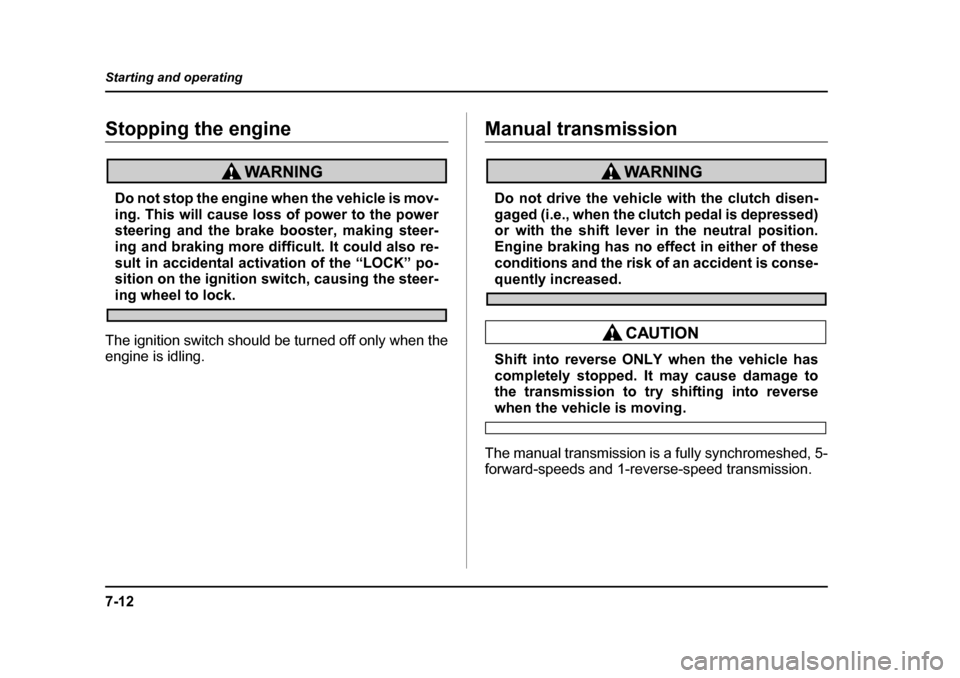
7-12
Starting and operating
Stopping the engine
Do not stop the engine when the vehicle is mov-
ing. This will cause loss of power to the power
steering and the brake booster, making steer-
ing and braking more difficult. It could also re-
sult in accidental activation of the “LOCK” po-
sition on the ignition switch, causing the steer-
ing wheel to lock.
The ignition switch should be turned off only when the
engine is idling.
Manual transmission
Do not drive the vehicle with the clutch disen-
gaged (i.e., when the clutch pedal is depressed)
or with the shift lever in the neutral position.
Engine braking has no effect in either of these
conditions and the risk of an accident is conse-
quently increased.
Shift into reverse ONLY when the vehicle has
completely stopped. It may cause damage to the transmission to try shifting into reverse
when the vehicle is moving.
The manual transmission is a fully synchromeshed, 5-
forward-speeds and 1-reverse-speed transmission.
Page 266 of 469
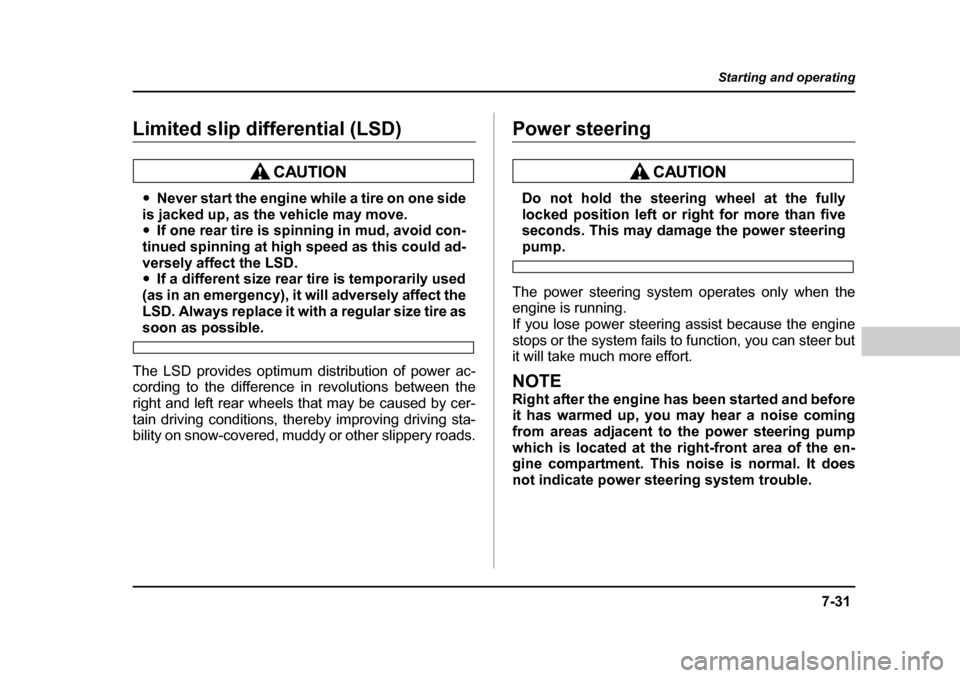
7-31
Starting and operating
– CONTINUED –
Limited slip differential (LSD)
�yNever start the engine while a tire on one side
is jacked up, as the vehicle may move. �y If one rear tire is spinning in mud, avoid con-
tinued spinning at high speed as this could ad-
versely affect the LSD.�y If a different size rear tire is temporarily used
(as in an emergency), it will adversely affect the
LSD. Always replace it with a regular size tire as
soon as possible.
The LSD provides optimum distribution of power ac-
cording to the difference in revolutions between the
right and left rear wheels that may be caused by cer-
tain driving conditions, thereby improving driving sta-
bility on snow-covered, muddy or other slippery roads.
Power steering
Do not hold the steering wheel at the fully
locked position left or right for more than five
seconds. This may damage the power steering
pump.
The power steering system operates only when the
engine is running.
If you lose power steering assist because the engine
stops or the system fails to function, you can steer but
it will take much more effort.
NOTE
Right after the engine has been started and before
it has warmed up, you may hear a noise coming
from areas adjacent to the power steering pump
which is located at the right-front area of the en-
gine compartment. This noise is normal. It does
not indicate power steering system trouble.
Page 269 of 469

7-34
Starting and operating
The ABS system prevents the lock-up of wheels which
may occur during sudden braking or braking on slip-
pery road surfaces. This helps prevent the loss of
steering control and directional stability caused by
wheel lock-up.
When the ABS system is operating, you may hear a
chattering noise or feel a slight vibration in the brake
pedal. This is normal when the ABS operates.
The ABS system will not operate when the vehicle
speed is below approximately 6 mph (10 km/h). �„
ABS system self-check
You may feel a slight shock in the brake pedal and
hear the operating sound of ABS from the engine com-
partment just after the vehicle is started. This is
caused by an automatic functional test of the ABS sys-
tem being carried out and does not indicate any abnor-
mal condition. �„
ABS warning light
The ABS warning light comes on when the ignition
switch is turned to the “ON” position and goes out after
about two seconds.
This is an indication that the ABS system is working
properly.
If the warning light behaves as follows, the ABS
system may not be working properly.
When the warning light is on, the ABS function
shuts down; however, the conventional brake
system continues to operate normally.
UB4010GA
Page 272 of 469
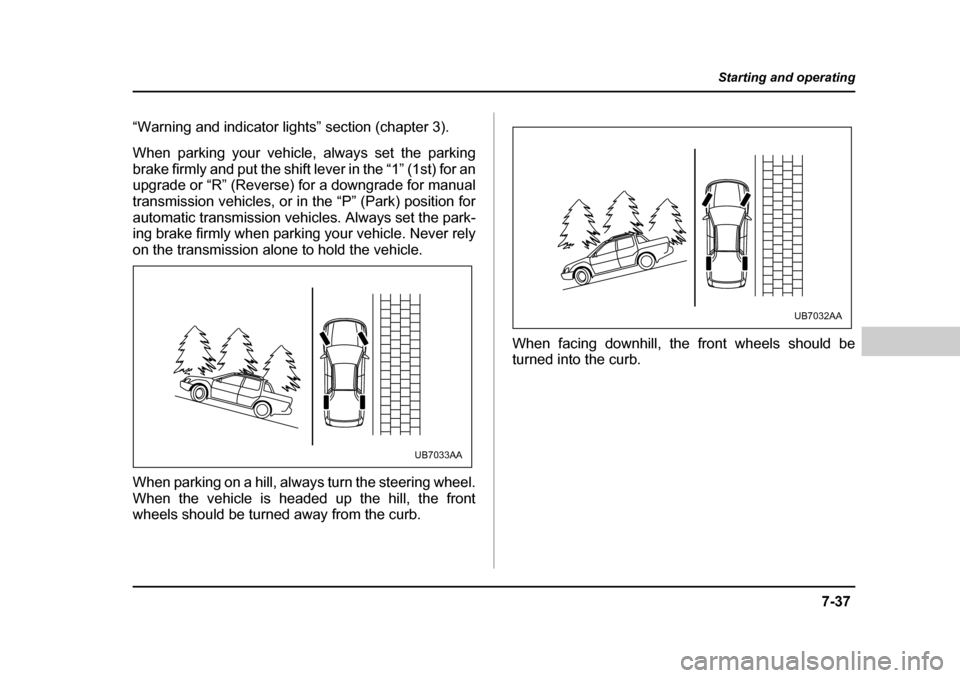
7-37
Starting and operating
– CONTINUED –
“Warning and indicator lights” section (chapter 3).
When parking your vehicle, always set the parking
brake firmly and put the shift lever in the “1” (1st) for an
upgrade or “R” (Reverse) for a downgrade for manual
transmission vehicles, or in the “P” (Park) position for
automatic transmission vehicles. Always set the park-
ing brake firmly when parking your vehicle. Never rely
on the transmission alone to hold the vehicle.
When parking on a hill, always turn the steering wheel.
When the vehicle is headed up the hill, the front
wheels should be turned away from the curb. When facing downhill, the front wheels should be
turned into the curb.
UB7033AA
UB7032AA